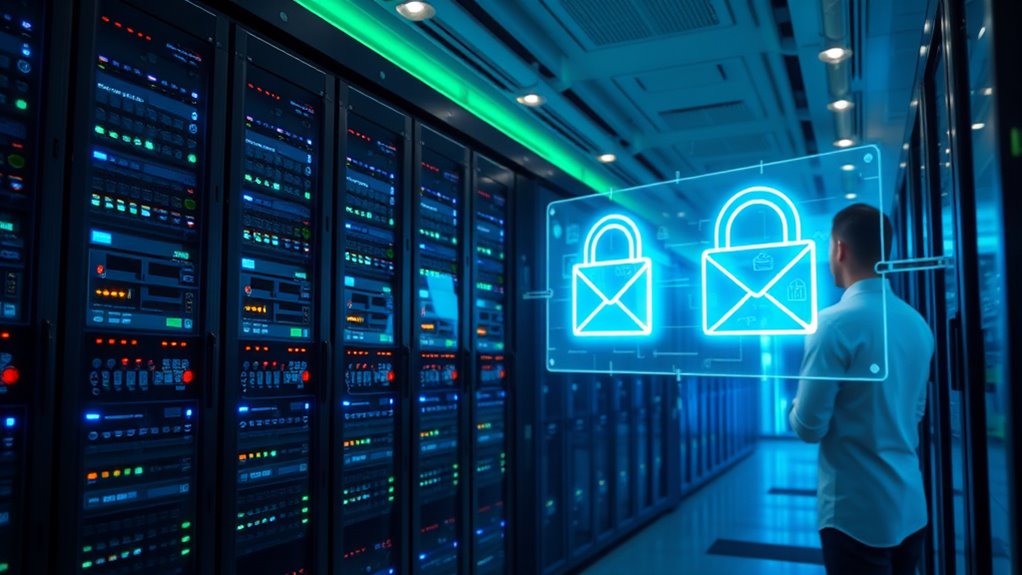Top email providers protect your data with advanced security measures like encryption protocols, including TLS and end-to-end encryption, to keep your messages confidential. They also use sophisticated phishing detection systems that flag suspicious links and fake sender addresses, preventing malicious attacks before they reach your inbox. Regular security updates, multi-factor authentication, and activity monitoring further strengthen your account safety. Keep exploring to discover more ways these services guard your online communication effectively.
Key Takeaways
- Top providers implement advanced phishing detection to identify and block suspicious links, fake addresses, and malicious language patterns.
- They utilize encryption protocols like TLS and end-to-end encryption to keep email content confidential during transmission.
- Continuous security updates and audits ensure encryption standards and access controls remain resilient against emerging threats.
- Multi-layered defenses combine phishing prevention, encryption, secure login, and activity monitoring for comprehensive protection.
- Providers foster user confidence by maintaining proactive security measures that safeguard personal and professional data effectively.

Have you ever wondered how secure your email platform really is? Protecting your messages from unauthorized access isn’t just about installing a good password; it’s about the sophisticated measures top providers implement behind the scenes. One of the key strategies they use is phishing prevention. Phishing remains one of the most common ways cybercriminals try to compromise your account. Top email services deploy advanced detection systems that analyze incoming emails for suspicious links, fake sender addresses, and unnatural language patterns. These systems automatically flag or block potential phishing attempts, giving you a warning before you even open a harmful email. By filtering out these threats early, they help prevent your sensitive data from falling into the wrong hands.
Alongside phishing prevention, encryption protocols form the backbone of secure email communication. When you send an email, encryption transforms your message into a code that only the intended recipient can decode. This process ensures that even if someone intercepts your email during transmission, they can’t understand its content. Leading providers typically use Transport Layer Security (TLS) for securing emails in transit, which encrypts the connection between your device and their servers. For added protection, many services also offer end-to-end encryption, meaning your message is encrypted from your device all the way to the recipient’s device. This level of encryption guarantees that nobody, not even the email service provider, can read your message without the decryption key.
These encryption protocols aren’t just technical jargon; they’re essential for maintaining your privacy. Top providers continuously update and strengthen their encryption standards to stay ahead of evolving cyber threats. They also implement strict access controls and regularly audit their security measures to ensure your data remains confidential. In addition, many services offer features like secure login methods, multi-factor authentication, and activity monitoring, all designed to prevent unauthorized access. Furthermore, staying informed about AI vulnerabilities can help providers identify and mitigate emerging threats more effectively. Together, these measures create a robust shield around your email communication, making it extremely difficult for hackers to infiltrate.
In essence, the security of your email platform hinges on a combination of proactive measures like phishing prevention and strong encryption protocols. When these systems work in tandem, they create a layered defense that not only deters cyberattacks but also safeguards your personal and professional information. As someone who relies on email daily, understanding these protections can help you make smarter choices about your online security. Rest assured, the best providers are committed to staying one step ahead of cybercriminals, constantly refining their security tools so you can communicate with confidence.
Frequently Asked Questions
How Do Providers Handle Zero-Day Vulnerabilities in Email Security?
When zero-day vulnerabilities emerge, providers act swiftly by leveraging advanced phishing defense and malware detection tools to identify and block threats before they cause damage. They often deploy real-time threat intelligence updates and machine learning algorithms to detect unusual activity. You benefit from rapid patching and continuous monitoring, ensuring your email remains secure. This proactive approach helps minimize risks and keeps your data protected against even unknown vulnerabilities.
What Are the Latest Encryption Standards Used by Top Email Providers?
Your data’s security is like a fortress, thanks to the latest encryption standards. Top email providers now use end-to-end encryption to guarantee only you and your recipient can read your messages. They also rely on TLS protocols, often upgrading to TLS 1.3, which offers faster, more secure data transfer. These standards keep your emails private, making it nearly impossible for hackers to intercept or decipher your sensitive information.
How Is User Privacy Maintained During Data Breaches?
During data breaches, top email providers prioritize your privacy safeguards by quickly detecting the breach and implementing a thorough breach response. They notify you promptly, limit data exposure, and work to contain the incident. Advanced encryption and anonymization techniques are used to protect your sensitive information. These proactive measures ensure your privacy remains as intact as possible, minimizing potential harm and restoring trust swiftly.
Do Providers Offer Multi-Factor Authentication Options Beyond Passwords?
Think of security like a fortress—multi-factor authentication is your secret weapon. Yes, providers often offer password alternatives, such as biometric scans or one-time codes sent to your device. These multi-factor authentication options strengthen your defenses, making it considerably harder for intruders to access your account. By adding an extra layer beyond just passwords, you’re actively safeguarding your data and keeping your email platform secure from potential threats.
How Frequently Are Security Protocols Updated and Tested?
You’ll find top providers update and test their security protocols regularly, often through scheduled security audits and continuous monitoring. They also conduct user training to make sure you understand best practices, reducing vulnerabilities. This proactive approach helps identify potential threats early, keeping your data safe. By staying vigilant and updating protocols frequently, these providers ensure your email platform remains secure against evolving cyber threats.
Conclusion
Now that you know how top providers safeguard your data, aren’t you glad your emails are in safe hands? With advanced encryption, multi-layered defenses, and constant monitoring, they’re working tirelessly to keep your information private and secure. So, next time you hit send, ask yourself: do you trust your email platform to protect what matters most? Rest easy knowing that your inbox is guarded by the best in the business.
Natali – Editor in Chief (Strategy and Mastery, AI Expert) Natali, our Editor in Chief, is the driving force behind our content’s strategic direction. With a keen eye for detail and a deep understanding of market trends, Natali ensures that our content is top-notch and strategically aligned with our client’s goals. Her expertise in AI helps to seamlessly integrate advanced technology into our marketing strategies, pushing the boundaries of conventional marketing.









![Personalization Basics: Beyond "Hello [Name]" in Your Emails 13 advanced email personalization techniques](https://leftbrainmarketing.net/wp-content/uploads/2025/11/advanced_email_personalization_techniques_7bop8-260x140.jpg)
